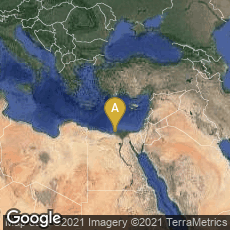

A: Alexandria Governorate, Egypt
Like the works of Archimedes, the writings of the Greek geometer and astronomer Apollonius of Perga were not widely studied in the ancient world, and almost nothing is known of his life. Apollonius is believed to have lived in the second half of the third century BCE. From references to Archimedes in Apollonius' writings it is believed that the two men might have known one another. Apollonius is also thought to have spent time in Alexandria.
Apollonius' Conics was originally written in eight books, probably on eight separate papyrus rolls. The Conics are famous for recognizing
and naming the ellipse, parabola and hyberbola, among other things. Only books I-IV survived in the original Greek, from copies made on
parchment at the Royal Library of Constantinople. They were organized early in the sixth century, probably at Alexandria, by the mathematician Eutochius of Ascalon who also edited, and thus probably preserved, the writings of Archimedes. Books V-VII of the Conics survived separately in Arabic translation, and Book VIII was lost, though some idea of its contents can be inferred from lemmas to it in the writings of the Greek mathematician Pappus of Alexandria, whose works survived in more complete form.
Books I-IV of the Conics were first published in print in the Latin translation by Giovanni Battista Memo, a professor of mathematics at Venice. The edition was published in Venice by Bernardino Bindoni in 1537, one year after Memo's death. The Greek manuscript that Memo used is unknown; his edition is very rare on the market.
In the first half of the 17th century the Medici family acquired an Arabic manuscript containing Books V-VII of the Conics, which had been lost up to that time. In 1658, with the help of the Maronite scholar Abraham Ecchellensis (Ibrahim ibn Daud al-Haqili), Giovanni Borelli prepared an edited Latin translation of the manuscript, which was published in print in Rome in 1661.
Traditionally, Books I-IV of the Conics were collected in the Latin translation of the mathematician and humanist Federico Commandino
published in 1566. It was Commandino who also translated from Greek into Latin the writings of Archimedes (after the editio princeps),
Pappus, the Pneumatics of Heron of Alexandria, and Euclid.
Hook & Norman, The Haskell F. Norman Library of Science & Medicine (1991) Nos 57 & 58.